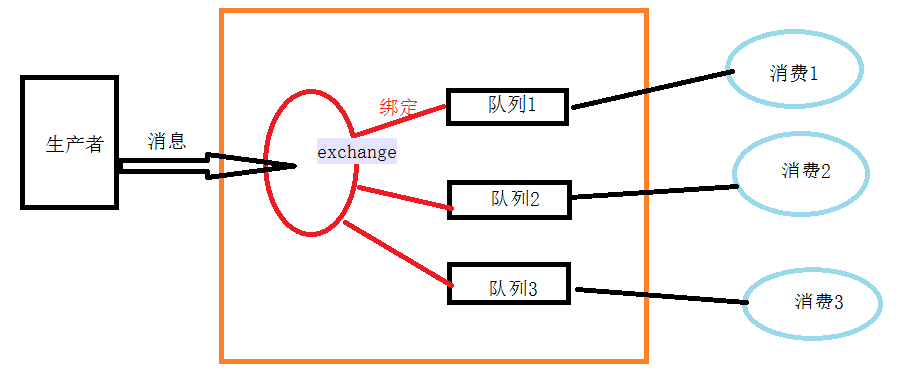简单队列方式
#!/usr/bin/env python # -*- coding:utf-8 -*- import Queue import threading #建立队列长度为10 message = Queue.Queue(10) #生产者 def producer(i): #往队列中扔消息 message.put(i) print('queue_size=%s'%message.queue) #消费者 def consumer(i): #取队列消息,先进先出 msg = message.get() #生产线程 for i in range(10): t = threading.Thread(target=producer, args=(i,)) t.start() #消费线程 for i in range(5): t = threading.Thread(target=consumer, args=(i,)) t.start() #打印剩余的数据 print('queue_size=%s'%message.queue)
结果:
生产队列增长过程过程
producer_queue=deque([0])
producer_queue=deque([0, 1])
producer_queue=deque([0, 1, 2])
producer_queue=deque([0, 1, 2, 3])
producer_queue=deque([0, 1, 2, 3, 4])
producer_queue=deque([0, 1, 2, 3, 4, 5])
producer_queue=deque([0, 1, 2, 3, 4, 5, 6])
producer_queue=deque([0, 1, 2, 3, 4, 5, 6, 7])
producer_queue=deque([0, 1, 2, 3, 4, 5, 6, 7, 8])
producer_queue=deque([0, 1, 2, 3, 4, 5, 6, 7, 8, 9])
剩余数据
queue=deque([4, 5, 6, 7, 8, 9])
以下是RabbitMQ 主要模式
1简单队列
2exchange{
1、fanout
2、direct
3 、topic
}
安装组件
pip install pika
对于RabbitMQ来说,生产和消费不再针对内存里的一个Queue对象,而是某台服务器上的RabbitMQ Server实现的消息队列。
1、简单队列模型、消息不丢失持久化参数durable
生产者

1 # -*- coding:utf-8 -*- 2 import pika 3 #认证的用户密码 4 credentials = pika.PlainCredentials('openstack', 'RABBIT_PASS') 5 #远程主机配置 6 parameters = pika.ConnectionParameters('172.16.21.5',5673,'/',credentials) 7 8 #封装socket逻辑部分,拿到操作句柄 9 connection = pika.BlockingConnection(parameters) 10 channel = connection.channel() 11 12 13 #创建队列名字为hello,这个队列的名字一般是唯一的.消费者连接的信道名称也是这个 14 channel.queue_declare(queue='hello') 15 16 # 第一种工作状态 17 #basic_publish设置队列 18 # exchange='' 就是简单队列的意思,这里exchange不工作 19 # routing_key='hello' ,exchange不工作了那么这里如何处理,就靠routing_key来找对应队列 20 #bodybody='Hello World!' 这就是传递的数据 21 channel.basic_publish(exchange='', 22 routing_key='hello', 23 body='Hello World!') 24 channel.basic_qos(prefetch_count=1) 25 print(" [x] Sent 'Hello World!'") 26 connection.close()
消费者

1 # -*- coding:utf-8 -*- 2 import pika 3 #认证的用户密码 4 credentials = pika.PlainCredentials('openstack', 'RABBIT_PASS') 5 #远程主机配置 6 parameters = pika.ConnectionParameters('172.16.21.5',5673,'/',credentials) 7 connection = pika.BlockingConnection(parameters) 8 channel = connection.channel() 9 10 11 #消费者这里也创建一个队列,实际中生产者或消费者不一定谁先启动,如果消费者直接去没有创建的队列拿数据会直接报错 12 channel.queue_declare(queue='hello') 13 14 #回调函数 15 def callback(ch, method, properties, body): 16 print(" [x] Received %r" % body) 17 #no_ack=false 必须在回调函数中加入下面的方法 18 #ch.basic_ack(delivery_tag = method.delivery_tag) 19 20 #获取队列中 21 #queue='hello'获取hello队列的消息 22 #no_ack=True(无应答)false(有应答).如果callback函数会执行很长时间如果期间消费者机器出问题那么(无应答)模式消息取从队列 23 #中取走后就会删除掉的,无法找回。(有应答)队列必须等待callback正确执行完在删除队列消息 24 channel.basic_consume(callback, 25 queue='hello', 26 no_ack=True) 27 28 print(' [*] Waiting for messages. To exit press CTRL+C') 29 channel.start_consuming()
消息获取顺序
默认队列中有12消息,三个消费者,A四个消息、B四个消息、C四个消息。BC处理块A处理慢就会变成A继续处理消息,BC闲置
channel.basic_qos(prefetch_count=1) 表示谁来谁取,不再按照奇偶数排列

1 #消费者增加下面的方法 2 channel.basic_qos(prefetch_count=1) 3 4 channel.basic_consume(callback, 5 queue='hello', 6 no_ack=False)
2、exchange工作模型(fanout,direct,topic)
fanout模式

1 #!/usr/bin/env python 2 # -*- coding:utf-8 -*- 3 import pika 4 import sys 5 credentials = pika.PlainCredentials('openstack', 'RABBIT_PASS') 6 parameters = pika.ConnectionParameters('172.16.21.5',5673,'/',credentials) 7 connection = pika.BlockingConnection(parameters) 8 channel = connection.channel() 9 10 #exchange创建一个交换机名为logs,并且设置类型为fanout 11 channel.exchange_declare(exchange='logs', 12 type='fanout') 13 14 message = 'exchange :type=fanout' 15 #指定名为logs的交换机,这里使用exchange,routing_key就不需要了。 16 channel.basic_publish(exchange='logs', 17 routing_key='', 18 body=message) 19 print(" [x] Sent %r" % message) 20 connection.close()

1 #!/usr/bin/env python 2 # -*- coding:utf-8 -*- 3 import pika 4 5 credentials = pika.PlainCredentials('openstack', 'RABBIT_PASS') 6 parameters = pika.ConnectionParameters('172.16.21.5',5673,'/',credentials) 7 connection = pika.BlockingConnection(parameters) 8 channel = connection.channel() 9 10 11 #用意和之前一样 12 channel.exchange_declare(exchange='logs', 13 type='fanout') 14 15 #创建一个队列 16 result = channel.queue_declare(exclusive=True) 17 #给队列随机命名 18 queue_name = result.method.queue 19 20 #将消费者队列和交换机(exchange='logs')进行绑定 21 channel.queue_bind(exchange='logs', 22 queue=queue_name) 23 24 25 print(' [*] Waiting for logs. To exit press CTRL+C') 26 27 #回调函数 28 def callback(ch, method, properties, body): 29 print(" [x] %r" % body) 30 31 channel.basic_consume(callback, 32 queue=queue_name, 33 no_ack=True) 34 #阻塞函数 35 channel.start_consuming()
原理:
这种模式就是广播形式,生产者的消息会同时发送到所有消费者上
关键之匹配(direct模式)
这个模式上在上图增加了route key 。生产者发送消息的时候会绑定一个route key,消费者订阅消息也必须绑定route key 。这样一来就可以使用同一个交换机但可以接受自己关心的消息
原理:

生产者

1 #!/usr/bin/env python 2 import pika 3 import sys 4 5 credentials = pika.PlainCredentials('openstack', 'RABBIT_PASS') 6 parameters = pika.ConnectionParameters('172.16.21.5',5673,'/',credentials) 7 connection = pika.BlockingConnection(parameters) 8 channel = connection.channel() 9 10 #建立交换机和类型 11 channel.exchange_declare(exchange='direct_logs', 12 type='direct') 13 #route key 14 severity = 'info' 15 message = 'exchange:type direct' 16 #发送消息 17 channel.basic_publish(exchange='direct_logs', 18 routing_key=severity, 19 body=message) 20 print(" [x] Sent %r:%r" % (severity, message)) 21 connection.close()
消费者

1 #!/usr/bin/env python 2 import pika 3 import sys 4 5 credentials = pika.PlainCredentials('openstack', 'RABBIT_PASS') 6 parameters = pika.ConnectionParameters('172.16.21.5',5673,'/',credentials) 7 connection = pika.BlockingConnection(parameters) 8 channel = connection.channel() 9 10 #创建交换机和类型 11 channel.exchange_declare(exchange='direct_logs', 12 type='direct') 13 14 #创建队列 15 result = channel.queue_declare(exclusive=True) 16 #设定随机队列名 17 queue_name = result.method.queue 18 19 #消费者一个队列可以绑定多个routekey 20 severities = ['info','error'] 21 22 #循环多个routekey 23 for severity in severities: 24 #绑定叫交换机、队列、routekey 25 channel.queue_bind(exchange='direct_logs', 26 queue=queue_name, 27 routing_key=severity) 28 29 print(' [*] Waiting for logs. To exit press CTRL+C') 30 31 #回调函数 32 def callback(ch, method, properties, body): 33 print(" [x] %r:%r" % (method.routing_key, body)) 34 35 #指定回调函数 36 channel.basic_consume(callback, 37 queue=queue_name, 38 no_ack=True) 39 #阻塞等待 40 channel.start_consuming()
topic(模糊匹配)
exchange type = topic
在topic类型下,可以让队列绑定几个模糊的关键字,之后发送者将数据发送到exchange,exchange将传入”路由值“和 ”关键字“进行匹配,匹配成功,则将数据发送到指定队列。
#匹配模式写在消费者中
abc.123.abc abc.* -- 不匹配 ,* 表示只能匹配 一个 单词
abc.123.abc abc.# -- 匹配 ,# 表示可以匹配 0 个 或 多个 单词
消费者

1 #!/usr/bin/env python 2 # -*- coding:utf-8 -*- 3 import pika 4 import sys 5 6 credentials = pika.PlainCredentials('openstack', 'RABBIT_PASS') 7 parameters = pika.ConnectionParameters('172.16.21.5',5673,'/',credentials) 8 connection = pika.BlockingConnection(parameters) 9 channel = connection.channel() 10 11 #创建交换机和类型 12 channel.exchange_declare(exchange='topic_logs1', 13 type='topic') 14 15 #创建队列 16 result = channel.queue_declare(exclusive=True) 17 #设定随机队列名 18 queue_name = result.method.queue 19 20 #消费者一个队列可以绑定多个routekey 21 #消费者中用模糊匹配abc.* 这个只能匹配一个字母 22 severities = ['abc.*'] 23 24 #循环多个routekey 25 for severity in severities: 26 #绑定叫交换机、队列、routekey 27 channel.queue_bind(exchange='topic_logs1', 28 queue=queue_name, 29 routing_key=severity) 30 31 print(' [*] Waiting for logs. To exit press CTRL+C') 32 33 #回调函数 34 def callback(ch, method, properties, body): 35 print(" [x] %r:%r" % (method.routing_key, body)) 36 37 #指定回调函数 38 channel.basic_consume(callback, 39 queue=queue_name, 40 no_ack=True) 41 #阻塞等待 42 channel.start_consuming()
生产者

1 #!/usr/bin/env python 2 # -*- coding:utf-8 -*- 3 import pika 4 import sys 5 6 credentials = pika.PlainCredentials('openstack', 'RABBIT_PASS') 7 parameters = pika.ConnectionParameters('172.16.21.5',5673,'/',credentials) 8 connection = pika.BlockingConnection(parameters) 9 channel = connection.channel() 10 11 #建立交换机和类型 12 channel.exchange_declare(exchange='topic_logs1', 13 type='topic') 14 #route key'abc.1' 15 severity = 'abc.1' 16 message = 'exchange:type topic route_key=abc.#' 17 #发送消息 18 channel.basic_publish(exchange='topic_logs1', 19 routing_key=severity, 20 body=message) 21 print(" [x] Sent %r:%r" % (severity, message)) 22 connection.close()
结果:
[*] Waiting for logs. To exit press CTRL+C
[x] 'abc.1':'exchange:type topic route_key=abc.1'
